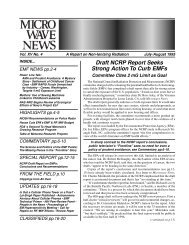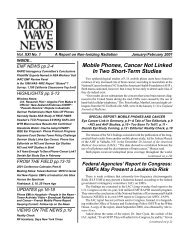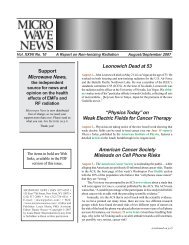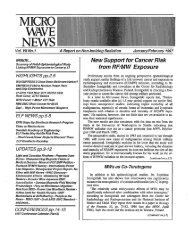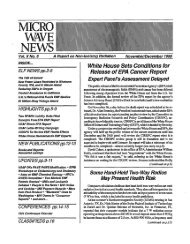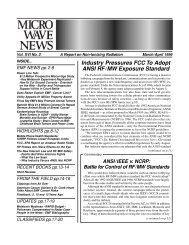Microwave News - November/December 1985
Microwave News - November/December 1985
Microwave News - November/December 1985
Create successful ePaper yourself
Turn your PDF publications into a flip-book with our unique Google optimized e-Paper software.
HIGHLIGHTS<br />
Navy: Last year, the Navy stopped working on ELF<br />
bioeffects at its Aerospace Medical Research Lab in Pen-<br />
sacola, FL (see MWN, September 1984). The Office of<br />
Naval Research still has a few ongoing projects, however.<br />
*EPRI: This is the one exception. EPRI expects to in-<br />
crease its funding level by 40 percent: from $1.7 million in<br />
<strong>1985</strong> to $2.4 million in 1986. Dr. Bob Patterson, project<br />
manager for EPRI's studies on the bioeffects of electric<br />
and magnetic fields, said that he planned to start a National<br />
Science Foundation-+ program for "less directed and<br />
more creative" research with some of the new money.<br />
- Brookhaven Lab<br />
Dr. Arland Carsten's plight at Brookhaven National<br />
Laboratory is a microcosm of the whole non-ionizing radi-<br />
ation research community. He and his coworkers have<br />
completed a study of reproductive and multi-generational<br />
effects of 60 Hz electric and magnetic fields on mice at<br />
Brookhaven's Medical Department in Upton, NY. (They<br />
found no significant effects on a large number of end<br />
points in results reported to date.) Carsten's experiment<br />
cost $585,000 - over ten percent of the total NY project's<br />
funds. Unless he can find a new source of money, how-<br />
ever, Carsten will soon have to give up the specially<br />
equipped lab he built for the study, due to keen competi-<br />
tion for space. "The lab would be perfect for a study of<br />
ELF and leukemia and cancer, an issue on a lot of people's<br />
minds," he told <strong>Microwave</strong> <strong>News</strong>. He said he has gone<br />
everywhere for research grants hut has come up empty-<br />
banded.<br />
"The replacement cost of the exposure facility would<br />
likely be more than $500,000. Many Brookhaven staffers<br />
supported me to get the lab and equipment ready for this<br />
study, otherwise I could never have built it within the<br />
budget. It's a pity to dismantle it when there are so many<br />
unanswered questions," he said.<br />
The predicament faced by ELF researchers is similar to<br />
that of those who work at higher frequencies (see MWN,<br />
March <strong>1985</strong>).<br />
60 Hz Fields Induce Neurologic<br />
Changes in Monkeys<br />
Power line frequency electric and magnetic fields can<br />
alter the balance of neurotransmitters in monkeys. This<br />
finding by researchers at the New York State Department<br />
of Health Laboratories in Albany is the fust to implicate 60<br />
Hz electromagnetic fields with changes in neurologic func-<br />
tion.<br />
Speaking at a meeting of contractors working on the ef-<br />
fects of power line radiation held in Alexandria, VA, on<br />
<strong>November</strong> 6, Dr. Richard Seegal reported that monkeys<br />
exposed to a varied schedule of electric and magnetic<br />
fields for 63 days showed significant and replicable reduc-<br />
tions in the concentrations of homovadlic acid (HVA) and<br />
5-hydroxyindoleacetic acid (5-HIAA) in their cerebrospinal<br />
fluid (CSF). HVA and 5-HIAA are metabolites of<br />
dopamine and serotonin, respectively, two important<br />
neurotransmitters which are linked to motor activity,<br />
mood, emotion and sleep.<br />
Decreases in HVA and 5-HIAA may indicate decreases<br />
in the firing activity of neurons and changes in circadian<br />
rhythms, according to Seegal. Changes in the concentra-<br />
tion of HVA in the CSF minor alterations in the brain,<br />
and, while the same may be true for 5-HIAA, it is possible<br />
that 5-HIAA concentrations in the CSF reflect changes in<br />
spinal cord metabolism.<br />
Seegal and his coworkers, Drs. Robert Dowman and Jon<br />
Wolpaw, found that the decreases in HVA appeared to be<br />
dose-dependent and reversible. Although the decreases in<br />
5-HIAA also appeared to depend on the dose, they did not<br />
appear to be reversible.<br />
No Excess Leukemia Among Wisconsin Electrical Workers<br />
Wisconsin electrical workers had a normal rate of consistent patterns of elevated risk. They wrote:<br />
leukemia mortality behveen 1963 amd 1978, accord- "We believe that the available evidence concerning<br />
ing to a letter in the <strong>December</strong> 5 New England Jour- the possible association between occupational field<br />
nal of Medicine. exposnre and leukemia risk should be viewed with<br />
The finding by Drs. Eugenia Calle of the Centers caution until workplace exposures are more realisti-<br />
for Disease Control in Atlanta, GA, and David cally considered and adequate epidemiologic studies<br />
Savitz of the University of Colorado Medical School are conducted on particular cohorts of interest.''<br />
in Boulder, CO, appears to contradict earlier reports Savitz is currently working on an attempted repli-<br />
by Drs. Samuel Milham and William Wright (see cation study of Nancy Wertheimer's epidemiological<br />
MWN. July/Angust and <strong>December</strong> 1982, respec- study that linked electromagnetic fields with child-<br />
. tively). The new study used the same occupational hood cancer (see MWN, September 1983). Results<br />
groupings as these previous studies. are due this summer. Savitz is moving to the De-<br />
Calle and Savitz advised that the current practice partment of Epidemiology at the University of North<br />
of combining various occupations into one group of Carolina School of Public Health in Chapel Hill at<br />
"electrical workers" to test hypotheses is not sup- the beginning of the year.<br />
portable either by considerations of exposure or by<br />
4 MICRO WAVE NEWS <strong>November</strong>l<strong>December</strong> <strong>1985</strong>



